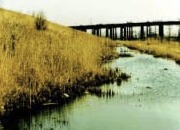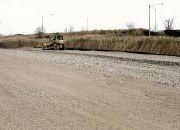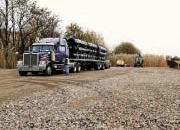Municipal Sanitary Landfill Authority
MSLA 1-D
1500 Harrison Avenue
Kearny Town, Hudson County
PI # 132232
Block: 285
Lot: 2
June 2017
The New Jersey Department of Environmental Protection (NJDEP) has contracted with A. Servidone Inc./B. Anthony Construction Corp./Barbella Construction Services to perform
remedial actions to cap and contain pollution at the Municipal Sanitary Landfill Authority (MSLA) 1D Landfill site (NJDEP Preferred Identification # 132232) located at 1500
Harrison Avenue in Kearny, Hudson County.
Site History
The Municipal Sanitary Landfill Authority (MSLA) 1D Landfill is located near Exit 15 W of the NJ Turnpike, at 1500 Harrison Avenue, in the Town of Kearny, Hudson County. The
primary waste fill mound is situated on 94 acres designated as Block 285, Lot 2, which is owned by the Town of Kearny. Additional waste fill is present on Block 285, Lot 2A,
owned by the New Jersey Department of Transportation (NJDOT). The MSLA 1D Landfill lies within the Hackensack Meadowlands District. The landfill property is vacant except
for an abandoned landfill gas recovery and processing facility. Access to the site is from Harrison Avenue.
Aerial photographs from 1961-1962 of the area around the site show it to be primarily wetlands. In the 1970s, the landfill property was leased by the Town of Kearny to the
MSLA. In 1977, the MSLA obtained approval from NJDEP, allowing the site to be used for landfilling. By 1978, aerial photographs show that the majority of wetlands had been
filled. In addition, a variety of industrial-type wastes were reportedly disposed of. The landfill was reopened and accepted waste again between 1981 and 1982, but was
never properly closed. The NJDEP ordered the landfill to cease operations in 1982, due in part to the fact that it had reached its maximum allowable height and that the
MSLA had failed to maintain the leachate control system.
The United States Environmental Protection Agency’s (USEPA) contractors performed sampling and investigations. The USEPA Site Investigation Report, dated September 1990, did not rank the site high enough for placement on the National Priorities List. NJDEP issued a Remedial Action Plan (RAP), dated November 1999, calling for construction of an impermeable cap, slurry wall, and leachate collection system. NJDEP completed installation of some site improvements at the landfill in July 2010, to allow for the more extensive closure construction work that is currently beginning. Improvements included a perimeter road around the toe of the landfill, fencing, gas pipeline removal and relocation, and construction of a leachate pump station and force main.
Previous Investigations
Hazardous organic and inorganic compounds have been detected in the ground water at the site. The depth to ground water at the site is relatively shallow. Shallow ground
water discharges locally into adjacent wetlands and surface water. There is no evidence that the landfill was constructed with a bottom liner, therefore, leachate is free
to drain out of the waste materials and directly into ground water. It is estimated that up to 83,000 gallons/day of leachate flows to the Passaic River. Volatile organic
compounds, polyaromatic hydrocarbons (PAHs), pesticides and metals were detected in the soils. In addition to chemical compounds detected in the soils, previous site
investigations have observed wastes on the surface of the site. These include medical wastes, chemical drums, and large tanks. There are significant gaseous emissions
from the landfill which are not controlled as the site was not properly capped and the original gas extraction system is no longer in operation.
Remedial Actions
The work will be organized into two main actions.
- Leachate control to mitigate contamination of surface water and ground water.
- Landfill capping to control gas emissions, prevent direct contact with contaminated materials, and reduce leachate generation.
Before landfill capping, leachate control measures will be implemented. The landfill is daily discharging thousands of gallons of contaminated leachate into the ground
water and the surrounding wetlands. This represents the most visible and direct threat to human health and the environment. Also, historically, there has been concern
about the stability of the MSLA 1D Landfill. The initial installation of a leachate collection system will allow the landfill to dewater to some degree and increase in
stability prior to adding the additional weight of a cap. A subsurface barrier wall is proposed to enclose the waste material. The wall will be keyed into the sand,
silt, and clay formation at depths of approximately 50 feet. To facilitate construction of the subsurface wall and leachate collection system, clearing and grading of
portions of the site will be required. Excavations for the barrier wall will generate considerable volumes of soil which will be disposed of on top of the landfill and
will require proper grading and capping.
On the landfill side of the wall, a leachate collection trench will be installed at a level below the off-site ground water table elevation. It will convey leachate
contained within the wall to a pump station to be built onsite. From there the leachate will be piped to a pump station at the MSLA 1A Landfill which is owned by the
Kearny Municipal Utilities Authority (KMUA). There it will be combined with leachate from the MSLA 1A and MSLA 1E Landfills and disposed of into the sewer system for
conveyance to the Passaic Valley Sewerage Commission’s (PVSC) treatment plant. These actions will contain, collect, and dispose of the landfill leachate to prevent
its migration into off-site ground water and its discharge into surface waters and wetlands.
The second major action will consist of constructing an impermeable cap over the landfill, including a landfill gas collection system. A cap will control storm water
infiltration into the landfill which results in leachate production. Additional benefits include the control of gas emissions and prevention of direct contact of
humans and animals with exposed, contaminated materials. There are several components to the landfill cap. Initially the site will be graded to minimize soil erosion and
maximize storm water runoff. The construction of the cap will begin with the installation of a gas collection system and a cushioning layer for the overlying liner. A
synthetic plastic liner will be placed above the gas collection layer to prevent the infiltration of storm water into the underlying waste. The liner will be chemically
compatible with materials it may come in contact with and be able to accommodate stresses caused by settling. Over the liner will be a drainage layer to allow storm water
to drain off of the top of the liner. The uppermost layer of the cap will consist of topsoil capable of supporting vegetative growth. The thickness of the cap above the
liner will be sufficient to prevent frost, animal, and root damage to the liner.
During construction, which is anticipated to last up to two years, dust control measures will be taken to minimize the off-site migration of dust. To prevent soil erosion
and reduce off-site sediment transport, a soil erosion and sediment control plan has been prepared, identifying the measures to prevent soil loss and off-site damages,
measures to establish proper vegetation, and post-closure maintenance procedures. The aforementioned activities will be conducted in accordance with the current NJDEP
Technical Requirements for Site Remediation, N.J.A.C. 7:26E, and all applicable NJDEP Technical Guidance.
A copy of major environmental reports related to this site will be made available at a local information repository to be located at:
Kearny Public Library
Reference Librarian
318 Kearny Avenue
Kearny, NJ
(201) 998-2666
* For frequently asked questions about specific contaminants, please visit: http://www.atsdr.cdc.gov/toxfaqs/index.asp
|
Related Links
Community Relations Coordinator
Mark Herzberg (609) 633-1369

Landfill Leachate and Runoff |

Staging Area |

|
|


